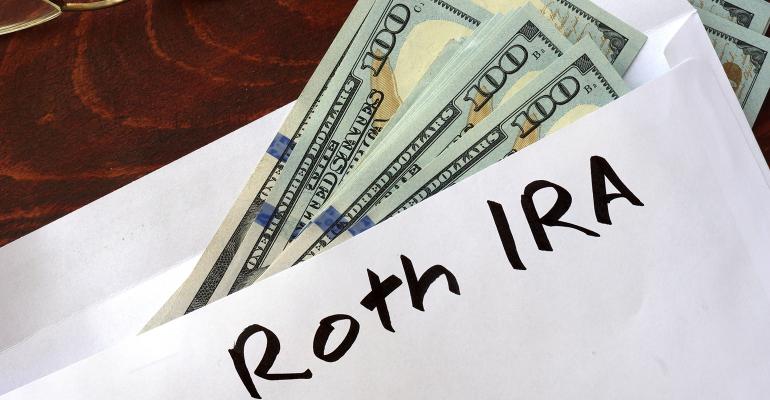Many investors own traditional individual retirement accounts that received pretax contributions during their careers. These assets shouldn’t be viewed in a similar vein as taxable accounts or Roth IRAs because any distributions trigger income taxes. Therefore, the value of these accounts needs to be discounted by the marginal rate at which they’ll be taxed. For instance, an investor who owns a traditional IRA worth $1 million and pays a combined federal and state rate of 30% should only value that IRA at $700,000. This discounting process often causes dissonance because it’s difficult for an investor to admit to owning less than the face value of the account.
The IRS allows account holders to convert these traditional plans to Roth IRAs at once or gradually over time. Any assets converted to Roth status are treated as taxable income on federal and state returns. However, any assets converted to Roth status are tax-free for the duration of the account holder’s life and potentially the lives of his spouse and children. The conversion process can be likened to ripping a Band-Aid off a scab and enduring a flash of pain (paying higher than normal taxes), but getting the relief afterwards of being beyond the ache of taxes forever.
Benefits and Downsides
I recently analyzed the benefits and downsides of a Roth conversion for a client who had already started taking required minimum distributions (RMDs). I assumed a steady market return and level tax rates and contrasted the hypothetical asset values of the Roth IRA after conversion and the traditional IRA plus a phantom taxable account that received the RMDs. This exercise is very difficult to model because it’s impossible to determine future investment returns, future tax rates and lifespans. A particularly tricky facet involved discounting the after-tax returns of a taxable account compared with an IRA because dividend, interest and capital gains taxes apply to the taxable account, while the Roth IRA is truly tax-free.
When Conversion Is More Attractive
I expected that converting to a Roth IRA would be the superior strategy. However, the analysis suggested that the difference between asset values post conversion was less than anticipated. The scenario assumed a fairly long period of compounding returns for the Roth IRA to “catch up” to the traditional IRA that remained unconverted. Regardless, there were a few factors that make converting to a Roth more attractive. These include:
Higher incomes/tax rates in retirement. During retirement, most people earn less than during their working years. However, a few individuals and families have higher retirement incomes due to tax deductions they were able to take while working and then large distributions from those tax-deferred accounts after age 70. Tax rates themselves may also rise due to future legislation. I believe this scenario is likely because the federal government is running historically high deficits, and the federal debt is at an all-time high. State and local governments have also promised high benefits relative to current inflows. Therefore, if future tax rates are higher, it makes sense to convert to a Roth now and pay a lower rate rather than wait and pay higher rates over time because the net result will produce higher investment balances.
Children. If an investor is planning to leave retirement assets to children, converting to a Roth IRA is the more attractive option. Children who receive Roth distributions also pay no taxes on distributions while children who inherit traditional IRAs pay income taxes of those same distributions. Children are required to withdraw the funds over their lifetimes at a lower rate than the original owner because they’re much younger than their parents. The longer the period of compounding tax-free, the more beneficial the Roth becomes relative to the traditional IRA.
Taxable estate. Wealthy investors with taxable estates could also benefit from Roth conversions because the value of the estates will be decreased immediately by the income taxes paid after conversion. Lower estate values are a benefit because the estate tax is assessed at a top rate of 40%, which is higher than the top federal income tax rate of 37%. Certain state governments also assess estate taxes such that combined rates can exceed 50%.
Market downturn. I don’t believe that it makes sense to wait for a bear market to convert a traditional IRA to a Roth. Converting to a Roth IRA during a market downturn would allow a superior after-tax return because the income tax would be assessed on a lower valuation. Assuming the market then bounced back after conversion, the tax-free assets would be larger and escape future income taxes to benefit the owner. However, this strategy isn’t viable because it’s impossible to time market downturns and rebounds with any accuracy.
Future legislation. Future legislation outside of tax rates themselves could also make the conversion more or less attractive. For instance, the SECURE Act, which the House recently passed, limits the period over which children are permitted to withdraw IRA balances to 10 years. This change contrasts unfavorably to current law that allows lifetime withdrawals and makes Roth conversions less attractive. Whether or not to convert to a Roth IRA is very complicated and depends on each investor’s unique financial circumstances.
David Laidlaw is manager and co-chief investment officer at Eagle Ridge Investment Management, LLC.





